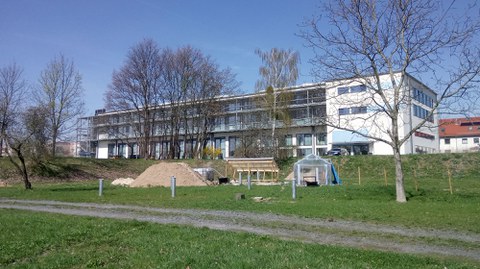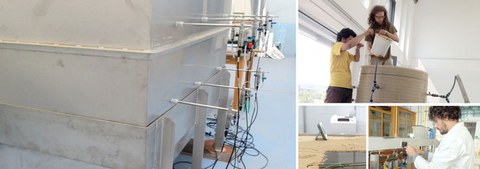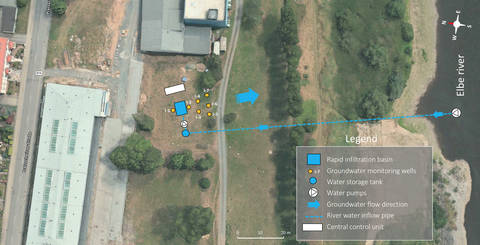Research infrastructure
Our group benefits of modern research infrastructure to address various challenges related to the characterisation and physical simulation of managed aquifer recharge processes. We are located at the TU Dresden external campus in Pirna, right on the banks of Elbe river, which offers us excellent opportunities for conducting various investigations at both laboratory and pilot scale.

INOWAS research infrastructure
Laboratory infrastructure
Decisive efficiency criteria for the operation of MAR schemes are the quantity of water that can be infiltrated and the quality of the water that reaches the aquifer. Both components are strongly influenced by clogging processes, which lead to a change in the soil water balance parameters (water content, matric potential, reducing and oxidizing conditions) as well as transport and conversion of infiltrated organic compounds.
Objectives
For a better understanding of these processes, we simulate at laboratory scale the MAR operation under various boundary conditions. The specific objective of the laboratory scale studies is to assess the influence of soil properties (soil type, porosity, hydraulic conductivity, water holding capacity) and operating conditions (infiltration rate, wet / dry ratio, water quality) on the clogging processes and clogging rates in both infiltration basins and infiltration wells. Observation and characterization of changes in the local water balance and in water transport processes during the application of MAR under various boundary conditions are intended to identify optimization approaches or ideal boundary conditions for the minimization of the clogging.

INOWAS-LAB collage
Physical models
For the characterisation of various processes occurring during MAR through surface infiltration basins and subsurface injection wells, we use a series of one, two and three-dimensional physical models equipped with automatic instrumentation for online parameter monitoring:
- one-dimensional soil columns of different materials, lengths and diameters for simulation of various infiltration scenarios and characterisation of clogging processes during MAR operation. Read more
- two-dimensional small-scale infiltration tank (L = 0.60 m; H = 0.45 m; W = 0.05 m) with transparent glass walls for visualisation of water infiltration front (also very suitable for characterisation of saltwater / freshwater interface). Read more
- three-dimensional big-scale rectangular infiltration tank (L = 1.50 m; W = 1.00 m, H = 1.00 m) for simulation of soil aquifer treatment (SAT) processes and clogging-related effects under MAR infiltration basins using different soils, water qualities, operation parameters and climatic conditions. Read more
- three-dimensional cylindrical lab-aquifer tank (D = 1.00 m; H = 1.20 m) for simulation of processes related to water infiltration through injection wells with focus on the effect of well screen length, well diameter, soil type, water quality etc. on system's efficiency. Read more
The experiments are carried out under controlled climatic conditions in a big-scale climate tent (L = 4.0 m; W = 2.5 m) with fully-automatic temperature and air humidity control, which allows a simplified assessment of the influence of the operating conditions.
Parameter estimation
Our INOWAS lab is also equipped with modern instrumentation for determination of various hydraulic soil properties. This includes estimation of soils' saturated and unsaturated hydraulic conductivity using different methods (soil grain size analysis, Darcy tests, Hyprop-based evaporation method etc.). Further analyses include determination of soil water retention curves (pF), internal pore size distribution and total porosity, as well as soil water saturation and water content. Suction cups are also available for extraction of pore water samples from the soil vadose zone. Additional parameters can be monitored online using modern sensors equipped with data loggers for automatic recording of matric water potential in the vadose zone, oxygen concentration in the pore water system, and soil water content using time domain reflectometry (TDR) sensors.
Field infrastructure
When a more close-to-nature approach is required, we conduct our research under pilot-scale conditions at the test-field located right behind our institute's building. The area of the test field is about 1 ha (200 x 50 m) and includes:

Location of INOWAS rapid infiltration basin and groundwater monitoring wells
- one rapid infiltration basin with L = 5.00 m; W = 4.00 m and H = 1.50 m equipped with a surface infiltration basin (1.35 x 0.90 m) and four layers of sensors with data loggers for continuous recording of soil matric water potential, soil water content and oxygen concentration in the pore water system, as well as suction cups for extraction and analysis of pore water samples. Read more
- seven groundwater monitoring wells (D = 5 inch; depth = 15 m below surface) positioned around the rapid infiltration basin and equipped with multi-probe SENSOdive unit with pressure, temperature and electrical conductivity sensors connected to data loggers, which allows instantanous profile measurements (IPM). The wells are used to validate the efficiency of the rapid infiltration basin and to simulate aquifer storage and recharge (ASR) measures. Read more
- eleven small-diameter piezometers (D = 1 inch; depth = ca. 14 m below surface) distributed over the whole test field area and equipped with pressure loggers for high-resolution characterisation of groundwater level fluctuations and surface water - groundwater interactions. Read more
